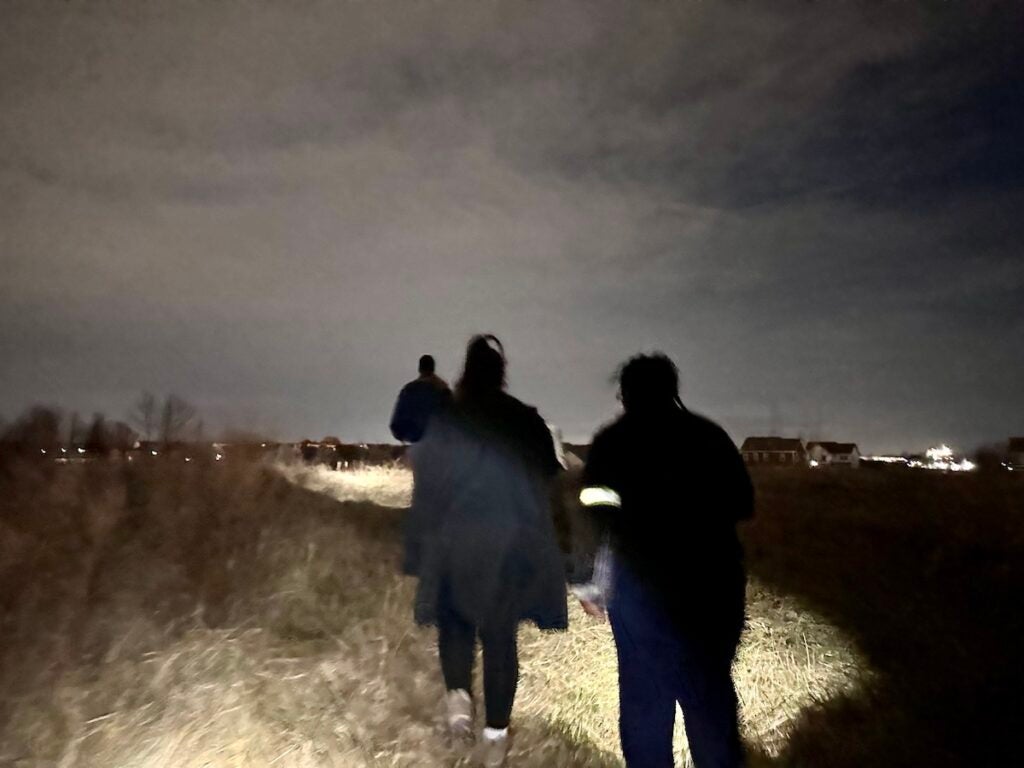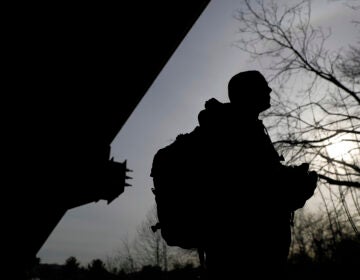An inside look at Delaware’s point-in-time count of people experiencing homelessness
Volunteers walked through rain-soaked forests to tabulate Delaware’s homeless population and offer assistance.
Listen 1:57
Volunteers make their way along the dim pathway, their boots muddied from the journey. (Johnny Perez-Gonzalez/WHYY)
From Philly and the Pa. suburbs to South Jersey and Delaware, what would you like WHYY News to cover? Let us know!
“Hello… it’s Brandywine [counseling]… anybody home? We’re here to do the PIT count.”
It’s 10 p.m. on a rainy January night and volunteers are walking through the woods of Dover near Delaware State University and other locations to visit encampments, shelters and other locations that provide shelter for people experiencing homelessness.
Every year around this time, organization leaders and groups that help people experiencing homelessness gather with volunteers to visit encampments, shelters and other locations that serve people who are unhoused. They conduct street outreach to distribute care bags to both the unhoused and individuals in emergency shelters, transitional housing and safe havens.
The aim of this collaborative effort is twofold: to offer support and resources as well as obtain a snapshot of homelessness on a single night.
As part of their quest to locate individuals living outside, Housing Alliance Delaware, the organizer of the annual point-in-time count, invited WHYY News to join volunteers from Brandywine Counseling’s outreach group in the wooded areas and dimly-lit streets of Kent County on Jan. 24.
Preparing for a long night that ended close to 2 a.m., the team drove to a Wawa store in Milford for a coffee break. With a brief glance, they spotted a veteran who appeared to be experiencing homelessness.
After giving permission for the group to collect his information for the count, he soon opened up and shared his story. He became homeless after his mother passed away, and circumstances forced him to give up their home. He interrupted as outreach workers asked if he was seeking resources. He told the volunteers he’s tried getting assistance, but didn’t find the state very helpful.
Like others the volunteers met, he was handed a care bag.
“We’ve switched to drawstring backpacks and they are filled with basic necessities and essential winter items for anybody we encounter during the count,” said Erin Gallaher, the Continuum of Care program manager with Housing Alliance Delaware.
In addition to the overdose reversing medication Narcan, the packs include “things like hats and hand warmers, first aid kits, and snacks. This year, we were able to work with [the Delaware Division of Substance Abuse and Mental Health] to get opioid response kits to go into the care bags for anybody who might need them. We have COVID tests, disposable thermometers and a ton of different items.”
The veteran’s story isn’t uncommon, PIT count organizers say. While the details may vary widely, there are plenty of similarities from people forced into homelessness after facing eviction to escaping domestic abuse. One woman the group met said she survived two instances of rape, which led her to flee her home and ultimately become homeless.

No answer
After a few stops, the volunteers arrived in Dover and approached a nearby encampment.
Making their way down a steep, muddy path illuminated only by the radiant full moon and covered by towering trees, the group encountered flooding a few steps in before stumbling upon a small community of roughly 10 tent homes. Despite attempts to engage with the occupants, a hushed silence enveloped the surroundings, broken only by the gentle rustle of leaves and branches underfoot and the fleeting presence of animals.
Why did they choose not to answer the calls?
The air of silence may have been due to media reports about complaints surrounding a tent encampment set up near Delaware State University’s Dover campus. There had been recent media reports about a Dover council member who took issue with people living in the woods close to campus.
Volunteers say the publicity may have instilled fear among those living in the woods nearby about the possibility of displacement, forcing them to start anew in a different location once again.
Heading to the final stop, the volunteers in the car were somewhat frustrated. Their primary concern revolved around the potential loss of trust from individuals due to media exposure, coupled with the realization that failing to count this group meant forfeiting the opportunity to secure additional federal funding.
“It’s not the most reliable source of data that we have just because it is a singular night and the validity of the count really does depend on the effectiveness of the account on a given year,” Gallaher said. “So how many volunteers were able to go out? What’s the weather look like? There’s a ton of different things that can affect the data.”
For the upcoming year, leaders from Brandywine Counseling and HAD suggested that maybe the next PIT count could start earlier in the evening.

Months of preparation
In simplest terms, the count helps leaders grasp the current homelessness count at that point in time.
“The point-in-time count is an annual count that we do every year. It is a statewide outreach effort and census count of every person who’s experiencing homelessness on a single night in Delaware,” said Gallaher. “It is used to provide a kind of snapshot of Delaware’s homeless response system in terms of the people who need housing and shelter on any given night.”
Gallaher emphasized the considerable preparation required to do the count, noting that it takes months and typically commences at the end of summer.
“Early October is where we really start to do our blanket outreach for the year. So we get the website set up, [and] the volunteer sign-up form. I would say late November early December is when it kind of kicks up. So that’s when we’re reaching out to different outreach teams across the state, different organizations that serve people experiencing homelessness,” she said.
As the PIT count draws near, about 80 volunteers participated in training sessions, including Narcan administration and briefing on the night’s proceedings. They were briefed on survey techniques, provided wardrobe suggestions, and informed about their assigned locations.
The count serves two main purposes: securing federal Housing and Urban Development funds for state homeless assistance services and driving advocacy and legislative efforts. It lays the foundation for informative discussions and shaping policies and solutions to address homelessness in the state.
The 2023 PIT count of Delaware showed 1,255 homeless individuals, a significant uptick in homelessness, especially among those unsheltered. The count happened during inclement weather, which impacted the number of unsheltered individuals counted. Leaders highlighted this number could have been even higher on a dry day.
“What we have seen is that there’s been a trend upwards in the unsheltered count,” Gallaher said. “So the number of people who are sleeping outside in cars and places not meant for habitation. Last year’s count was the largest unsheltered count in Delaware’s history from 2008. It was almost 200 people, which was about a 50 person increase, around 28%, from the prior year.”
‘Teach one, reach back, help others and uplift’
Motivated by a deeply personal experience, Tamara Powell, 49, a retired Air Force veteran, stepped into the central gathering room in Kent County on the night of the point-in-time count. Her expression serious yet imbued with passion, she shared her relative’s story with homelessness. Driven by empathy, she committed herself to the cause, determined to ensure that others facing similar circumstances would not be overlooked or forgotten.
“I know being homeless has a negative connotation where people see it as them possibly being lazy or not wanting to do more, but certain circumstances and situations in life is what causes some of these people to fall on hard times and therefore be out in the street,” she said. “We have to remember that it’s our job to reach back and uplift those once we move up.”
Her words of advice: “That’s the biggest thing for each one, teach one, reach back, help others and uplift.”

Get daily updates from WHYY News!
WHYY is your source for fact-based, in-depth journalism and information. As a nonprofit organization, we rely on financial support from readers like you. Please give today.






